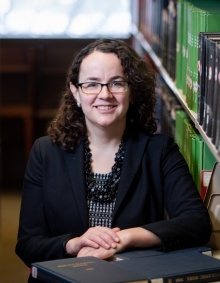Q&A with Betsy Bowen
“Innovation” – it doesn’t have to be a dirty word

Interview conducted and edited by Jana Eisenberg
In the spring of 2018, Assistant Professor Betsy Bowen wrote a guest blog for the National Center for Excellence in Homeless Services, where she discussed innovation in the context of homelessness services. The article, widely read, made us start thinking about the word “innovation,” which in Bowen’s piece, she refers to as “the ‘i’ word.”
Since the word, if not the practice, of “innovation” has become frequently used in corporate and nonprofit settings, we thought it bore a bit more discussion. Read on for an edited version of our conversation with Bowen.
Jana Eisenberg: Why did you feel you needed to write about innovation in this context—and why did you call it “the ‘i’ word”?
Betsy Bowen: I was calling out my own healthy skepticism; not that innovation as a whole is a bad thing, but as a buzz word people can throw it around without thinking of what they really mean. Then the word can become meaningless. The blog post came out of my reflection on that.
The starting point was the combination of my background as a practitioner and a course I co-taught during our Social Impact Fellows program. I was thinking about how the word is used in social work. When someone says, “You need to innovate XYZ,” it can sound like they’re saying that what you are doing isn’t good enough. So, sometimes when I hear it, I can feel a little defensive.
JE: How can innovation be discussed, especially in sensitive areas like working with homelessness services, without causing that sometimes-defensive reaction?
BB: True innovation includes asking the right questions of the right people. You need to listen to the people most directly affected by the problem. Before the word and the notion of “innovation” became so prevalent, social workers already thought in terms of things like systems change—that’s one of the things that distinguishes social work from other fields. We think about how changing one part will change the whole.
A good example of this is the Housing First model, which has since transformed the field of homelessness services. Through advocacy, and listening to clients, the model of providing housing for people experiencing homelessness was flipped. Instead of requiring that they be clean and sober in order to have access to housing, this innovation emphasizes getting people into housing first, and then helping them stabilize in other ways with access to services.
JE: Some definitions refer to collaboration (as part of innovation) as a “new competitive advantage.”
BB: The idea of collaboration is certainly not new to social workers. What’s new may be bringing collaboration to new spaces and types of partnerships. Collaboration, like innovation, is core to what social workers do. It can be beneficial to have partnerships between systems, government, and nonprofit and for-profit agencies. Ideally, it’s happening, and working to everyone’s benefit, but, mostly due to lack of resources, it doesn’t always happen as fully as it could.
A lot of my research, for example, has to do with young people who have experienced homelessness. My colleagues Annette Semanchin Jones and Annahita Ball study child welfare and education respectively, and what we realized in talking with each other is that it’s often the same children experiencing homelessness, dealing with the child welfare system and having trouble in school; all the systems know it—and they may even have good intentions of coordinating services. But, because of a lack of resources, the collaboration that would best serve these kids often isn’t there.
JE: Outside of the social work world, for example in politics, it seems like people are trying to “innovate” on topics/systems they don’t know a lot about. It’s also popular to turn to technology—“we need an app!”—to solve the problem.
BB: There are technology solutions that can help, say with addressing homelessness—but most are not going to solve the root of the issue. Like I said, a lot of it is resources. Providers are overwhelmed; if you are a social worker with an 800-kid caseload, it’s hard enough to just do your job. Social workers know that good collaboration is about relationships, trust and good communication; our research is showing that it’s hard to have those elements when you are overwhelmed.
JE: We’re hearing you say that to achieve innovation and collaboration, it can be a long road and takes many competent hands.
BB: Yes. Maybe part of innovation is simply realizing you don’t have to accept the status quo. Also right-sizing innovation doesn’t necessarily start with thinking that you are going to change the whole system, it can start with one program.